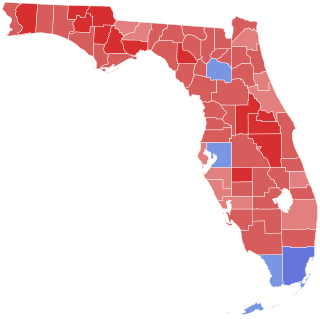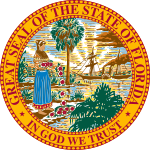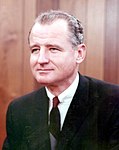
The 1962 United States Senate elections was an election for the United States Senate. Held on November 6, the 34 seats of Class 3 were contested in regular elections. Special elections were also held to fill vacancies. They occurred in the middle of President John F. Kennedy's term. His Democratic Party made a net gain of four seats from the Republicans, increasing their control of the Senate to 68–32. However, this was reduced to 67–33 between the election and the next Congress, as on November 18, 1962, Democrat Dennis Chávez, who was not up for election that year, died. He was replaced on November 30, 1962, by Republican appointee Edwin L. Mechem. Additionally, Democrat Strom Thurmond became a Republican in 1964, further reducing Democrats to 66–34. This was the first time since 1932 that Democrats gained seats in this class of Senators.

The 1970 Florida gubernatorial election took place on November 3, 1970, to determine the governor and lieutenant governor of Florida, concurrent with the election to the United States Senate, elections to the United States House of Representatives, and various state and local elections.

The 1966 Florida gubernatorial election took place on November 8, 1966. During the primary election, the results from the Democratic Party were close among three of the four candidates. Thus, the top two Democrat candidates – incumbent Governor of Florida William "Haydon" Burns and Mayor of Miami Robert King High – competed in a runoff election on May 24, 1966. In an upset outcome, Robert King High was chosen over W. Haydon Burns as the Democratic Gubernatorial nominee. In contrast, the Republican primary was rather uneventful, with businessman Claude Roy Kirk Jr. easily securing the Republican nomination against Richard Muldrew. This was the first time a Republican was elected governor since Reconstruction.

The 1974 Florida gubernatorial election took place on November 5, 1974. Incumbent Democratic Governor Reubin Askew won re-election to a second term.

The 1968 Florida United States Senate election was marked by the election of the first Republican to the United States Senate from Florida since Reconstruction.

The 1988 United States Senate election in Florida was held on November 8, 1988. Incumbent Democratic U.S. Senator Lawton Chiles decided to retire instead of seeking a fourth term. Republican Connie Mack III won the open seat, becoming the first Republican to hold this seat since Reconstruction in 1875.

The 1988 United States presidential election in Florida took place on November 8, 1988. All fifty states and the District of Columbia, were part of the 1988 United States presidential election. Florida voters chose twenty-one electors to the Electoral College, which selected the president and vice president.

The 1932 United States Senate election in Florida was held on November 8, 1932. Incumbent Democratic U.S. Senator Duncan U. Fletcher won re-election to a fifth term.

The 1988 United States presidential election in Arkansas took place on November 8, 1988. All fifty states and the District of Columbia, were part of the 1988 United States presidential election. State voters chose six electors to the Electoral College, which selected the president and vice president.

The 1968 United States Senate election in Missouri took place on November 5, 1968.

The 1968 United States Senate election in Kansas took place on November 5, 1968, concurrently with the U.S. presidential election as well as other elections to the United States Senate in other states as well as elections to the United States House of Representatives and various state and local elections.

The 1958 United States Senate election in Florida was held on November 4, 1958.

The regular-term 1956 United States Senate election in Kentucky took place on November 6, 1956. Democratic Sen. Earle Clements was defeated for re-election by Republican U.S. Representative Thruston B. Morton.

The 1956 United States Senate election in Florida was held on November 6, 1956. Incumbent Democratic U.S. Senator George Smathers won re-election to a second term.

The 1962 United States Senate election in Washington was held on November 6, 1962. Incumbent Democratic U.S. Senator Warren Magnuson won a fourth term in office, narrowly defeating Republican nominee Richard G. Christensen.

The 1962 United States Senate election in Kansas was held on November 6, 1962. Incumbent Republican Senator Frank Carlson was re-elected to a third term in office over Democratic nominee Ken Smith.

The 1964 United States Senate election in Florida was held on November 3, 1964. Incumbent Democratic U.S. Senator Spessard Holland was re-elected to a fourth term in office, defeating J. Brailey Oldham in the primary and Republican Claude R. Kirk Jr. in the general election.

The 1974 Tennessee gubernatorial election was held on November 5, 1974, to elect the next governor of Tennessee. Incumbent Republican governor Winfield Dunn was ineligible to run for re-election, as the Constitution of Tennessee prohibited governors from serving consecutive terms at the time. Democratic nominee Ray Blanton defeated Republican opponent Lamar Alexander with 55.4% of the vote.

The 1970 Tennessee gubernatorial election was held on November 3, 1970, to elect the next governor of Tennessee. Incumbent Democratic governor Buford Ellington was term-limited and was prohibited by the Constitution of Tennessee from seeking another term. Republican nominee Winfield Dunn, defeated Democratic opponent John Jay Hooker with 52.0% of the vote.

The 1966 Tennessee gubernatorial election was held on November 8, 1966, to elect the next governor of Tennessee. Incumbent Democratic governor Frank G. Clement was term-limited and was prohibited by the Constitution of Tennessee from seeking another term. Former Democratic governor Buford Ellington defeated both independent candidates H.L. Crowder and Charlie Moffett with 81.2% of the vote.






















